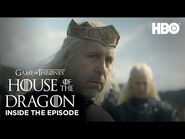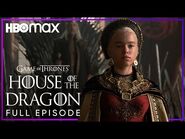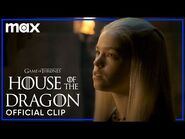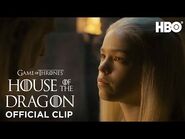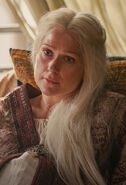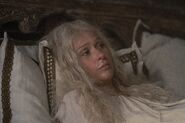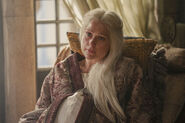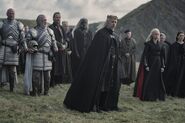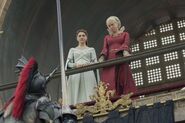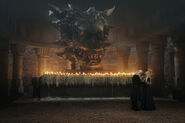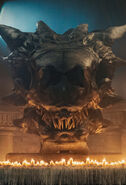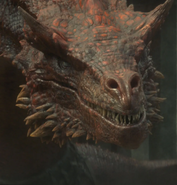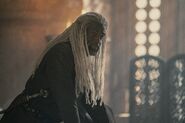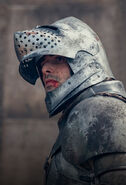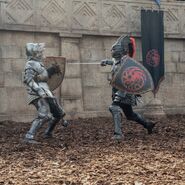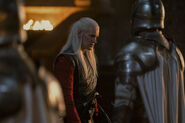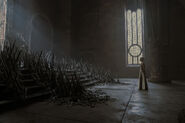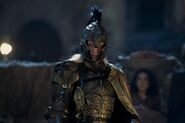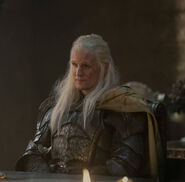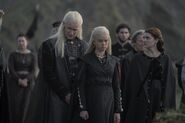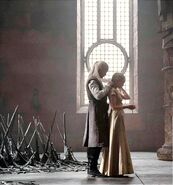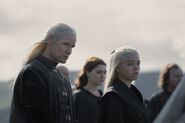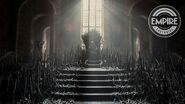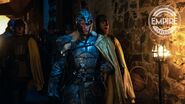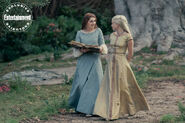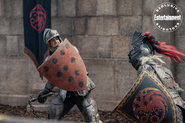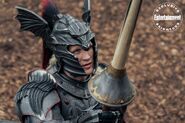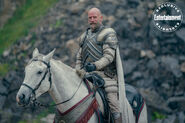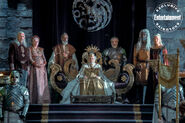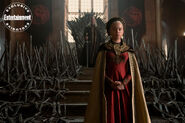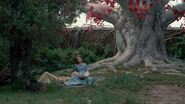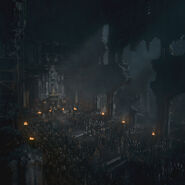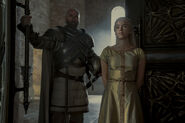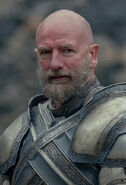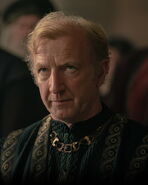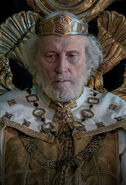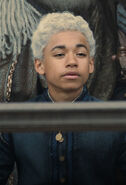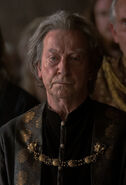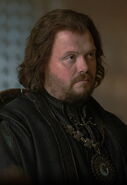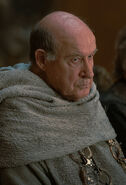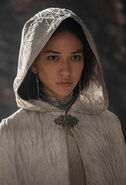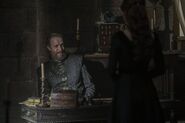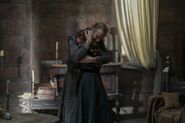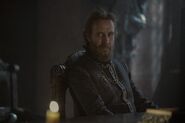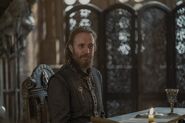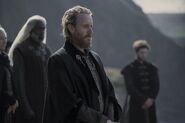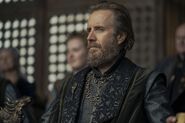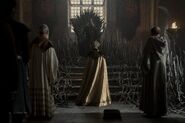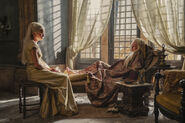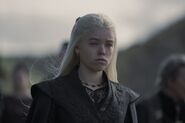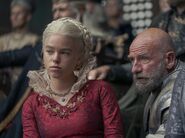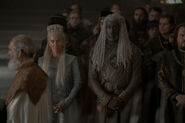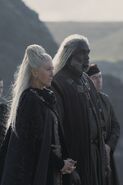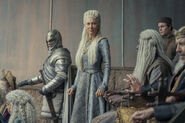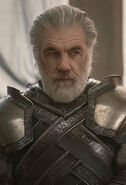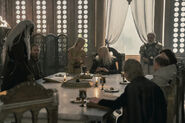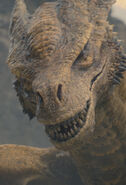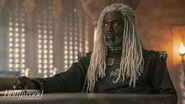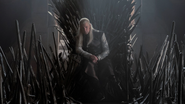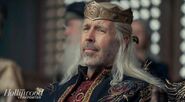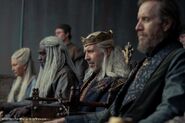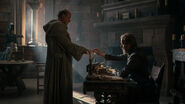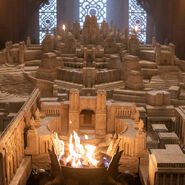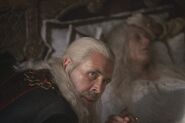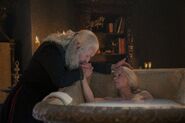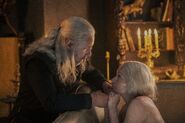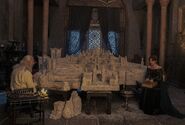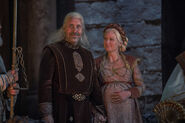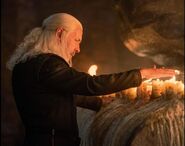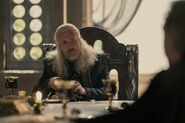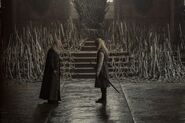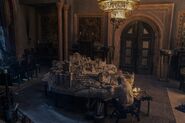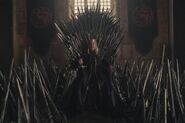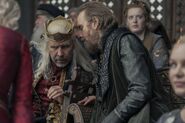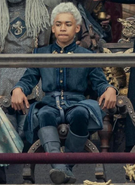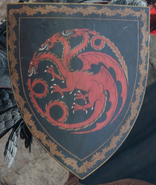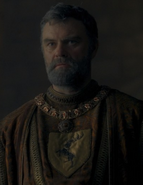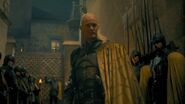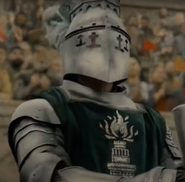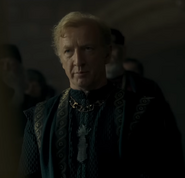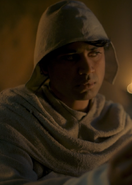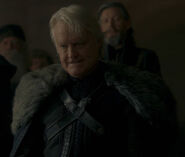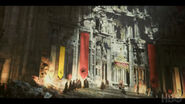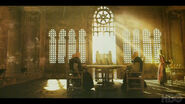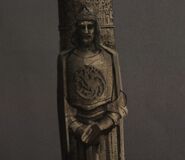- This page is about the episode. For other uses, see: The Heirs of the Dragon (disambiguation)
"The Heirs of the Dragon"[5] is the first episode of the first season of House of the Dragon. It is the first episode of the series overall. It premiered on August 21, 2022 on HBO and HBO Max. It was written by Ryan Condal and directed by Miguel Sapochnik.
Premise[]
Viserys hosts a tournament to celebrate the birth of his second child. Rhaenyra welcomes her uncle Daemon back to the Red Keep.[5]
Synopsis[]
Prologue: 11 years ago, at Harrenhal[]
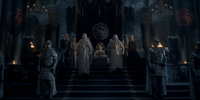
King Jaehaerys is presented with the final result of the Great Council.
In the year 101 AC,[a] the lords of Westeros gather in a Great Council to elect a Prince of Dragonstone to succeed Jaehaerys I Targaryen, following the deaths of the king's sons. Although fourteen claims are brought forward, only two are truly considered; those of Princess Rhaenys Targaryen, Jaehaerys's eldest grandchild, and Prince Viserys Targaryen, his eldest grandson. The Great Council elects Prince Viserys to succeed his grandfather.
In King's Landing[]
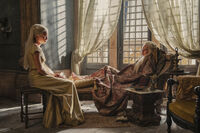
Aemma and Rhaenyra discuss childbirth.
It is now the year 112 AC,[b] nine years into Viserys's reign. High above King's Landing, his only daughter, Princess Rhaenyra Targaryen, flies across the city atop her dragon Syrax, landing her outside the gates of the Dragonpit. As the Dragonkeepers escort Syrax away, Rhaenyra is greeted by her sworn shield, Ser Harrold Westerling of the Kingsguard, and her friend, Lady Alicent Hightower. The two girls exchange comments on Syrax's growth before Rhaenyra invites Alicent to take a ride with her on Syrax, though Alicent politely declines. Ser Harrold and several men-at-arms escort Rhaenyra and Alicent in a covered wagon back to the Red Keep. Rhaenyra then pays a visit, with Alicent in attendance, to her heavily pregnant mother, Queen Aemma Arryn. Rhaenyra is dismissive of the idea of being a mother, but Aemma insists that as royal women, birthing royal children is how they serve the realm.
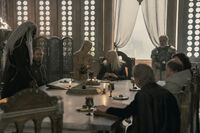
The Small Council discusses the Triarchy and the Heir's Tournament.
Within the Red Keep, Viserys hosts a meeting with his Small Council, with Rhaenyra in attendance as a cupbearer (though her father lightly chides her for being late to the meeting). His Master of Ships, Lord Corlys Velaryon, warns that the Free Cities have formed an alliance named the "Triarchy" and are trying to claim the Stepstones for themselves. Should the alliance eradicate the pirates currently inhabiting the Stepstones, Corlys warns, Westerosi ports could be badly affected, but his concerns are dismissed by Viserys and his Hand of the King, Ser Otto Hightower. The Master of Coin, Lord Lyman Beesbury, also complains to Viserys about the ruinous amounts of gold his younger brother, the absent Prince Daemon Targaryen, has spent in his new role as commander of the City Watch to properly arm and supply his men, but Viserys will hear no complaints against his brother. The discussion then turns to the upcoming "Heir's Tournament" Viserys has planned for the upcoming birth of his next child. Despite Grand Maester Mellos's insistence that there is no way of determining the sex, Viserys is confident the child will be a boy.
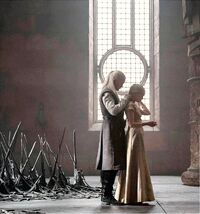
Daemon gives Rhaenyra a gift.
After the Small Council concludes, Rhaenyra and Ser Harrold head to the throne room, where they find Prince Daemon sitting on the Iron Throne. Ser Harrold is shocked by such disrespect, but Rhaenyra, used to her uncle's flippancy, is more amused. Rhaenyra and Daemon converse in High Valyrian, with Daemon, in his own words, noting the irony of Viserys throwing a tournament for his benefit (since until Viserys actually has a son, Daemon is his heir by law) before gifting his niece a bejeweled necklace of Valyrian steel. Later that evening, as Rhaenyra and Alicent spend time in the Red Keep's godswood, Rhaenyra concludes that she hopes her unborn sibling is a boy for the sake of her father's happiness, ignoring Alicent's remarks that a son would overshadow her in the line of succession. Elsewhere in the Red Keep, Viserys endures the Grand Maester treating a wound supposedly inflicted by the blades of the Iron Throne on his back that has become infected, before going to see his wife Aemma in her bath. Viserys tells her of his confidence their child will be a son, but Aemma insists that boy or girl, it will be their last; after several miscarriages and stillbirths, and one child dead in the cradle (a total of five within ten years), she can't bring herself to mourn another child.
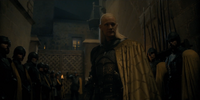
Daemon leads the City Watch.
As night falls, Daemon declares to the men of the City Watch, proudly identified by the gold cloaks he has bestowed upon them; that he has turned them from a disorganized rabble into a professional force to be reckoned with. He then leads them in a purge of the criminal elements of King's Landing, who are rounded up en masse to face summary justice; thieves lose a hand, rapers are castrated, murderers executed on the spot. At a Small Council meeting the following morning, at which Daemon is in attendance, Otto complains that the violence used by Daemon and his men was too excessive. Daemon defends his actions by pointing out that with most of Westeros's nobility coming to his brother's tournament, and the general lawlessness of King's Landing, extreme measures were warranted to ensure the safety of all of Viserys's subjects within the city walls. Corlys Velaryon also speaks in support of Daemon's actions, arguing the criminals of King's Landing should fear the City Watch. The discussion turns into a personal argument when Otto snipes that Daemon could put as much effort into his marriage as his work with the gold cloaks, insinuating Daemon should return to his wife's seat, Runestone, in the Vale of Arryn. Daemon scoffs that his wife, Lady Rhea Royce, is likely happier for his absence, derisively referring to her as his "bronze bitch." When Otto defends Lady Rhea's honor, Daemon sarcastically offers to give her to Otto as a replacement for his own late wife. Otto furiously rises to his feet at the insult, but Viserys defuses the argument, chiding Otto for letting Daemon provoke him while admonishing Daemon to police the city without the previous night's brutality. Later that night, Daemon complains to his mistress Mysaria, a brothel proprietor, about the lack of respect for his efforts shown by his brother and the Small Council. Mysaria reassures Daemon that, given his reputation and the power and prestige he possesses, the king can not so easily replace him.
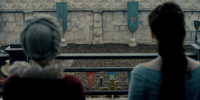
Alicent and Rhaenyra spectate as Ser Criston Cole jousts against a Tarly knight.
The following day, Viserys commences the Heir's Tournament with an announcement that Queen Aemma has gone into labor. Prince Daemon quickly becomes a favorite contender in the lists, further insulting Otto by picking as his first opponent his eldest son Ser Gwayne Hightower; he unhorses Ser Gwayne by striking at his mount's legs and then prods Alicent into granting her his favor for the tourney. Rhaenyra and Alicent are also intrigued by a new contender, Ser Criston Cole, after his unexpected victories against Lord Boremund Baratheon and his son, Ser Borros. As the tourney continues, a maester arrives and summons Viserys and Otto away. To Viserys's horror, Grand Maester Mellos explains that Queen Aemma's child is in breech, and that they must either cut open her womb to free the baby (a procedure that will almost certainly kill her) or risk losing both mother and child. Despite being appalled by the necessity of such a choice, Viserys grudgingly gives his consent, watching as the Grand Maester's acolytes hold down a delirious and screaming Aemma while Mellos cuts into her womb.
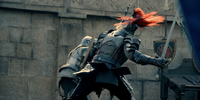
Daemon and Criston duel.
On the tourney grounds, Ser Criston manages to unhorse Daemon in the joust; furious at his unexpected defeat, Daemon angrily demands his sword to continue the fight in a melee. Ser Criston dismounts to oblige the prince, wielding a flail while Daemon fights with Dark Sister, one of the two ancestral Valyrian steel swords of House Targaryen. A savage duel ensues from which, to the shock of all spectators, Ser Criston emerges victorious. As a beaten and humiliated Daemon angrily storms off, Ser Criston approaches the royal box and asks Rhaenyra for her favor. Rhaenyra tosses down a floral wreath to him and bids him good luck in the rest of the tournament.
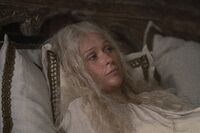
Queen Aemma tries in vain to give birth to Prince Baelon.
In the Red Keep, at his wife's bedside, Viserys weeps over Aemma's body, his wife having bled to death from the procedure to save their child. The Grand Maester informs Viserys that the child in question is a boy and hesitantly asks the king if he and the queen had chosen a name. Viserys answers "Baelon" (in honor of his own father), but at that moment, the infant prince begins choking in the Grand Maester's arms.
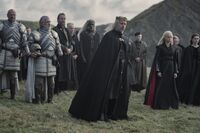
A funeral is held for Aemma and her son.
Several days later finds the royal court gathered at Rhaenys' Hill[6] for Queen Aemma and Prince Baelon's funeral. Viserys is near catatonic with grief, while Rhaenyra bitterly ponders to her uncle whether her father finally found happiness in the few short hours her brother lived. Daemon, sympathetic to his brother and niece's losses, urges Rhaenyra to support her father, insisting Viserys will need her more than ever, before Rhaenyra, with a command of "Dracarys" to Syrax, sets her mother and brother's funeral pyre ablaze.
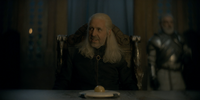
Viserys wearily discusses the succession with his Small Council.
The next day in the Small Council chamber, Otto presses Viserys to set his succession firmly in order. With Prince Baelon's death, Daemon is once again Viserys's heir presumptive, but Otto is adamant that Daemon cannot be allowed to sit on the Iron Throne and compares him to Maegor the Cruel, unaware that Daemon is listening to the entire conversation from the shadows. Viserys angrily dismisses Otto and Mellos's insinuations that Daemon would be willing to murder him to seize the crown, insisting that his brother lacks the patience to be king, and retorts to Otto's complaints that Daemon's command of the City Watch effectively gives the prince his own army by pointing out it was Otto's idea to give Daemon the command, given how vigorously Otto complained when Viserys named his brother Master of Laws and Master of Coin. Otto concedes the point, but argues that Daemon should be kept far from power. Corlys Velaryon asks who else would have a claim, to which Otto suggests Rhaenyra. Lord Lyonel Strong, the Master of Laws, vehemently protests this, arguing that Westeros has never had a queen and doing so would overturn centuries of tradition. Viserys refuses the notion of choosing between his daughter and his brother, so Corlys offers an alternative: his own wife Rhaenys; as the daughter of King Jaehaerys's eldest son Aemon, she has a valid claim to the throne, and a male heir (Laenor) to continue her line. Otto and Lyonel shout him down before a furious Viserys berates his Small Council for behaving like crows squabbling over a corpse while he is still mourning his wife and son, before storming out.
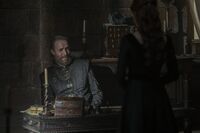
Otto commands Alicent to comfort the king.
Within the Tower of the Hand, Alicent pays her father a visit as Otto dispatches Mellos with a message to be sent by raven to Oldtown. Otto embraces his daughter, asking after Rhaenyra, before suggesting Alicent might offer her condolences to the princess's father as well. Though apprehensive about the request, Alicent complies, visiting Viserys in his chambers wearing her mother's dress and bearing a gift of a rare historical text, and offers her condolences at Queen Aemma's passing, for which Viserys thanks her. Later that evening, at a pleasure house on the Street of Silk, Daemon hosts a drunken orgy for several of his subordinates in the City Watch. Prompted by Myseria, Daemon raises a toast to his late nephew. Otto reports this event to Viserys, insisting that his sources claim Daemon dubbed Baelon "the Heir for a Day." While the context is ambiguous, Viserys takes it for an insult and summons his brother.
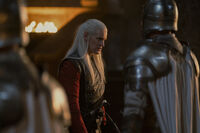
Daemon is disinherited by Viserys.
Viserys confronts Daemon in the throne room, seated upon the Iron Throne, the Targaryen sword Blackfyre in his hand, surrounded by his Kingsguard. Viserys angrily demands to know if Daemon truly mocked his nephew as the "Heir for a Day." When Daemon calls it his own way of showing grief, Viserys erupts at Daemon for celebrating his restored status with his "lickspittles" instead of consoling his brother and niece, and for throwing everything Viserys has given him back in the king's face. Daemon retorts that Viserys has only ever tried sending Daemon away from his side, and complains that even after ten years of rule, he has never offered him the role of Hand of the King. When Viserys scoffs at the notion, Daemon insists he deserves it as Viserys's brother, and that he would do a better job of it than Otto Hightower, who he describes as an overambitious second son out for himself. As Viserys defends his Hand, Daemon asserts that Otto doesn't protect his brother, whereas he would. When Viserys asks from what, Daemon bluntly replies "Yourself. You're weak, Viserys, and that council of leeches knows it. They all prey on you for their own ends."
Outraged by the insult, Viserys declares his intention to publicly name his heir. When Daemon insists he is his brother's heir, Viserys retorts "Not anymore" and orders Daemon to return to his wife's seat in the Vale. When Daemon steps forward to protest, the Kingsguard draw their swords and block his path, and Daemon grudgingly withdraws.
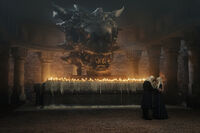
Viserys informs Rhaenyra of his decision.
Later that evening, Viserys summons Rhaenyra to Balerion's shrine within the bowels of the Red Keep. Rhaenyra is confused by the summons, given her father has barely spoken to her since her mother's funeral, and even more so when he asks her what she sees when she looks at the dragons. Staring at Balerion's skull, Rhaenyra admits that she sees their family; the people say that the Targaryens are closer to gods than to men, but it is only because of their control of the dragons. Viserys warns Rhaenyra that the dragons are a dangerous power, a power that caused the Doom of Valyria and might well destroy their family if they are not careful. He states that a Targaryen must always understand that truth if they aspire to be king or queen.
As his words sink in for Rhaenyra, Viserys apologizes for spending years chasing a son when he already had a worthy heir in his daughter. He insists that she has the makings of a great queen. To cement his trust in her, Viserys tells Rhaenyra a truth known only to their family: Aegon the Conqueror was not solely motivated by ambition to conquer Westeros. Like Daenys Targaryen foresaw the Doom of Valyria, Aegon had a vision that foretold the end of the world of Men. Aegon had a vision that the end would be preceded by a terrible winter descending from the North, and that what lurked within that storm would destroy the world of the living, unless the kingdoms of men united against it with a Targaryen to lead them. Since Aegon's time, a Targaryen king has passed knowledge of Aegon's vision, which he dubbed "The Song of Ice and Fire" to their heir, to ensure Westeros was ready when the evil Aegon foresaw finally descended upon mankind.
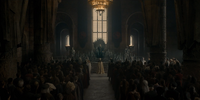
Rhaenyra is named Princess of Dragonstone.
Before a gathering of the realm's nobility, including the lords of Velaryon, Hightower, Stark, and Baratheon, Viserys bears witness as the nobles declare oaths of fealty to him and to Rhaenyra as his named heir. At the Dragonpit, Daemon, absent from the ceremony, presents Myseria to his own dragon Caraxes, before they both take flight on Caraxes's back.
Appearances[]
- Main page: The Heirs of the Dragon/Appearances
Firsts[]
|
Deaths[]
|
Cast[]
Notes[]
- 11 of 14 starring cast members appear in this episode.
- This includes an opening narration by Emma D'Arcy.
- Starring cast members Olivia Cooke (Alicent Hightower), Matthew Needham (Larys Strong), and Jefferson Hall (Jason and Tyland Lannister) are not credited and do not appear in this episode.
- Ferenc Berecz, Roberto Bonacini Benitez, Robert Bowen, David Cronnelly, Richard Hansen, Nicklas Hansson, David Hernández Silva, Gergö Horpácsi, Max Haeusle, Tsvetolyub Iliev, Rowley Irlam, Erin Jameson, Leigh Maddern, Alvaro Martin Ronco, Leona McCarron, Nikita Mitchell, Eduardo Moratilla, Antonio Ona Sanchez, Abian Padron, Elitsa Razheva, Ricardo Rocca, Ildebrando Rodriguez, Nick Roeten, Stanislav Satko, Paul Shapcott, Sam Stefan, Harvey Taylor, Pedro Torres, Marek Toth, Gyula Toth, Josh Wheeldon, Will Willoughby, Gábor Zámbó, Marco Bertagna, David Chapman, Joel Conlan, Ricardo Cruz Jr., Josh Dyer, Dan Euston, Pete Ford, Eduardo Gago Muñoz, Martin Gordon, Richard Hall, Rob Hayns, Erol Ismail, Gavin Lee Lewis, Oleg Podobin and Luke Tumber were stunts performers in this episode.
Quotes[]
- Rhaenyra (V.O.): "As the first century of the Targaryen dynasty came to a close, the health of the Old King, Jaehaerys, was failing. In those days, House Targaryen stood at the height of its strength, with ten adult dragons under its yoke. No power in the world could stand against it. King Jaehaerys reigned over nearly sixty years of peace and prosperity, but tragedy had claimed both his sons, leaving his succession in doubt. So, in the year 101, the Old King called a Great Council to choose an heir. Over a thousand lords made the journey to Harrenhal. Fourteen succession claims were heard, but only two were truly considered. Princess Rhaenys Targaryen, the king's eldest descendant, and her younger cousin, Prince Viserys Targaryen, the king's eldest male descendant."
- High Septon: "It is declared by all lords paramount and lords vassal of the Seven Kingdoms that Prince Viserys Targaryen be made Prince of Dragonstone."
- Rhaenyra (V.O.): "Rhaenys, a woman, would not inherit the Iron Throne. The lords instead chose Viserys, my father. Jaehaerys called the Great Council to prevent a war being fought over his succession, for he knew the cold truth. The only thing that could tear down the House of the Dragon was itself."
- — Rhaenyra narrates the Great Council at Harrenhal[src]
- Harrold: "Welcome back, princess. I trust your ride was pleasant."
- Rhaenyra: "You need not look so relieved, ser."
- Harrold: "I am relieved. Every time that golden beast brings you back unspoiled, it saves my head from a spike."
- — Harrold and Rhaenyra[src]
- "When I took command of the Watch, you were stray mongrels, starving and undisciplined. Now, you're a pack of hounds. You're sated and honed for the hunt. My brother's city has fallen into squalor. Crime of every breed has been allowed to thrive. No longer. Beginning tonight, King's Landing will learn to fear the color gold."
- ―Daemon Targaryen
- "The gods have yet to make a man who lacks the patience for absolute power, Your Grace."
- ―Otto Hightower
Corlys Velaryon: Who else would have a claim?
Otto Hightower: The king's firstborn child.
Lyonel Strong: Rhaenyra? A girl? No queen has ever sat the Iron Throne.
Grand Maester Mellos: That is only by tradition and precedent, Lord Strong-
Lyonel Strong: If order and stability so concern this council, perhaps we should not overturn one hundred years of it by naming a girl heir.
Viserys I Targaryen: I will not be made to choose between my brother and my daughter.
Corlys Velaryon: You wouldn't have to, Your Grace. There are others who would have a claim.
Lyonel Strong: Such as your wife, Lord Corlys? "The Queen Who Never Was"?
Corlys Velaryon: Rhaenys was the only child of Jaehaerys's eldest son. She had a strong claim at the Great Council and she already has a male heir.
Otto Hightower: Just moments ago, you announced your support for Daemon!
Lyonel Strong: If we cannot agree on an heir, then how can we expect the realm to…?
Viserys I Targaryen: My wife and son are dead! I will not sit here and suffer crows that come to feast on their corpses!
Viserys I Targaryen: "The Heir for a Day". Did you say it?
Daemon Targaryen: We must all mourn in our own way, Your Grace.
Viserys I Targaryen: My family has just been destroyed, but instead of being by my side or Rhaenyra's, you chose to celebrate your own rise! Laughing with your whores and your lickspittles! You have no allies at court but me! I have only ever defended you, yet everything I've given you, you've thrown back in my face!
Daemon Targaryen: You've only ever tried to send me away! To the Vale, to the City Watch, anywhere but by your side. Ten years you've been king and yet not once have you asked me to be your Hand!
Viserys I Targaryen: And why would I do that?
Daemon Targaryen: Because I'm your brother, and the blood of the dragon runs thick.
Viserys I Targaryen: Then why do you cut me so deeply?
Daemon Targaryen: I've only ever spoken the truth. I see Otto Hightower for what he is.
Viserys I Targaryen: An unwavering and loyal Hand?
Daemon Targaryen: A cunt. A second son who stands to inherit nothing he does not seize for himself.
Viserys I Targaryen: Otto Hightower is a more honorable man than you could ever be.
Daemon Targaryen: He doesn't protect you, I would!
Viserys I Targaryen: From what?
Daemon Targaryen: Yourself. You're weak, Viserys, and that council of leeches knows it.
- Viserys: "I am sorry, Rhaenyra. I have wasted the years since you were born wanting for a son. You are the very best of your mother, and I now believe, as I know she did, that you could be a great ruling queen."
- Rhaenyra: "Daemon is your heir…"
- Viserys: "Daemon was not made to wear the crown, but I believe that you are. This is no trivial gesture, Rhaenyra. A dragon's saddle is one thing, but the Iron Throne is the most dangerous seat in the realm."
- — Viserys and Rhaenyra[src]
- "There's something else that I need to tell you. It might be difficult for you to understand but you must hear it. Our histories... they tell us that Aegon looked across the Blackwater from Dragonstone and saw a rich land ripe for the capture. But ambition alone is not what drove him to conquest. It was a dream. And just as Daenys foresaw the end of Valyria, Aegon foresaw the end of the world of men. 'Tis to begin with a terrible winter gusting out of the distant north. Aegon saw absolute darkness riding on those winds, and whatever dwells within will destroy the world of the living. When this great winter comes, Rhaenyra, all of Westeros must stand against it, and if the world of men is to survive, a Targaryen must be seated on the Iron Throne, a king or queen strong enough to unite the realm against the cold and the dark. Aegon called his dream "The Song of Ice and Fire." This secret, it's been passed from king to heir since Aegon's time. Now you must promise to carry it and protect it. Promise me this, Rhaenyra. Promise me."
- ―Viserys I Targaryen
Behind the scenes[]
General[]
- With a run time of 66 minutes, this episode was the longest of the television series until it was dethroned by "The Princess and the Queen," two minutes longer at 68 minutes.
- The camerawork and cinematography in House of the Dragon are notably distinct from its predecessor Game of Thrones, even though this episode was directed by Miguel Sapochnik himself, a veteran director from the prior series. As he explained in an interview with Den of Geek, a key difference is that this story simply doesn't cover as many vastly different physical locations across different continents - so they no longer use color filters to distinguish them. On Game of Thrones, blue color filters were used at the Wall to give an impression that it's colder and at a higher altitude with less light, while King's Landing scenes used an orange color filter to give the impression it is a warmer climate, etc. Given that so much of House of the Dragon: Season 1 is set at King's Landing (and nearby Dragonstone and Driftmark), showrunners Sapochnik and Ryan Condal decided to drop the use of color filters, to let the natural colors "pop" on-screen, highlighting that this is the Targaryen golden age and full of bright, opulent heraldry.[7]
- The title of the episode derives from the chapter of Fire & Blood it is adapted from, "Heirs of the Dragon — A Question of Succession."
- Viserys is referred to by the full title, "King of the Andals and the Rhoynar and the First Men". Game of Thrones usually omitted mention of "and the Rhoynar" because Dorne wasn't introduced until Season 4 and the writers were unsure if they would ever appear.
- Viserys refers to bells tolling in the "Grand Sept" - but not the "Great Sept". The Great Sept of Baelor won't be built for another half-century. The Great Sept replaced an earlier one atop Visenya's Hill.
- Another way the skyline of King's Landing is different is that the Dragonpit atop Rhaenys's Hill is not yet in ruins, but a mega-structure on the scale of the Red Keep, used as a massive stable for the dragons.
- Other than the cold open prologue at Harrenhal, this episode is set entirely in King's Landing.
- When Daemon is introduced sitting on the Iron Throne, Harrold Westerling is shocked and Rhaenyra says he can't be heir if he's executed for treason. Only the king is allowed to sit on the Iron Throne - or if he is indisposed, the Hand of the King - and for anyone else including the designated heir to sit on it is officially treason (and Daemon isn't even the official heir at the time, only the presumed heir). Daemon's flippancy towards this rule immediately displays in his first scene how much of a rogue he is.
- The scene near the end of the end of the episode where Daemon remarks on the "heir for a day" in a brothel is the first of several "unreliable narrator" moments in Fire & Blood, due to the framing device that it is an in-universe history book with conflicting sources. Some sources say that Daemon's remark was repeated by the whore who was on his lap, while other "more plausible" ones say one of the Gold Cloaks, eager for a promotion, repeated it. The TV episode avoids directly showing how Otto found out about it, though it presents that Daemon was actually morose after the death of his brother's wife and son, not entertaining a whore on his lap. It then cuts away before showing what he said, or more importantly, how he said it: flippant and celebrating, or depressed and bitterly sarcastic.
- The scene of Rhaenyra and Alicent in the castle godswood prominently discusses a book about Nymeria, warrior-princess of the Rhoynar and founder of unified Dorne. Perhaps not coincidentally, at the time this was made HBO was actively considering a pitch for an additional prequel spinoff about the story of Nymeria, by writer Amanda Segel. By the time this episode aired, the Nymeria project advanced from the pitch phase and HBO ordered a full pilot episode script to be written, under the working title Ten Thousand Ships. Filming hasn't been greenlit yet, however, as HBO is waiting to see how well House of the Dragon performs.
- The scene near the end of the episode in which Viserys summons Rhaenyra to meet in front of Balerion's skull was the first scene that Milly Alcock filmed.[8]
- Costume designer Jany Temime gave several details about the extravagant "Investiture" outfit that Rhaenyra wears in the final scene of the episode. Temime described the overall design as "inspired by Byzantine elements", and explained that it looks so different from the other designs at court because it is not a contemporary design: the idea is that this is a ceremonial robe that "has been passed down for four or five generations", worn by each new Prince of Dragonstone when they were formally invested as heir to the throne. Thus the robe apparently goes back to the time of Aegon the Conqueror himself, used for his son and all subsequent kings for the next four generations (Aegon to his grandson Jaehaerys, and from Jaehaerys to his grandson Viserys). The heirloom investiture robe therefore offers a glimpse of earlier art styles from the Conquest generation, which are hinted to be more Byzantine-inspired. It took a team of three people ten weeks to embroider the entire outfit.[9] The "accessories", however, particularly the large earrings, were inspired by Moroccan wedding dresses.[10]
- During the early development of the series, George R.R. Martin suggested a first episode titled "The Heir and the Spare," centering on the relationship between Aemon and Baelon Targaryen, and leading up to their deaths. By Martin's account, he was the only one enthused by this idea.[11]
Filming locations[]
The home base for production has shifted from Titantic Studios in Belfast (on Game of Thrones) to the massive WB Leavesden Studios complex outside of London, England.
Exterior filming locations for this season included parts of England, Spain, and Portugal. In this episode:
- The first scene of Rhaenyra landing at the Dragonpit actually wasn't filmed in the Leavesden Studios backlot, but was instead filmed in a quarry located in the Peak District of northern England.
- Many of the King's Landing street scenes were filmed in Cáceres, Spain, which was previously used for King's Landing locations starting in Game of Thrones: Season 7.
- The funeral pyre scene for Rhaenyra's mother Queen Aemma, at a seaside cliff outside the city, was filmed in Devon, England. According to Ryan Condal, it was one of the most difficult exterior locations they filmed at in Season 1 due to its extreme remoteness, and they weren't allowed to use any real fire for the funeral pyre because it was a protected site.[9]
The new Red Keep set[]
- Because so many scenes are set in the Red Keep, all of the interior sets were combined into one large interconnected set: at various points the camerawork highlights this by following characters in uninterrupted cuts as they walk between rooms.[12]
- The new Red Keep set is 62 meters long, 39 meters wide, and 13.5 meters height at its tallest point. This includes multiple levels and functional staircases. The interiors have a combined area of 35,000 square feet. The entire combined set took four months to build.[9]
- The entire Red Keep is filled with erotic Valyrian tapestries, which according to the showrunners it meant to highlight that the series begins in an age of decadence and opulence, when the Targaryens are at their height and do not fear judgement by anyone (including the leadership of the Faith of the Seven).[9]
- The Iron Throne itself has been significantly expanded. As showrunner Ryan Condal explained, the Iron Throne in the books is 40 feet tall and requires a small stair to reach the seat - due to limits of budget and space the Iron Throne developed for the first season of Game of Thrones was a large chair made of melted swords (George R.R. Martin liked the design and considers it iconic, but always noted it wasn't what it's like in his books). Condal tried to meet this halfway: making it closer to Martin's vision while still honoring the original design. The result was that the "Iron Throne" is now a pile of melted swords that expands out and down the raised steps at the end of the hall, with the original Iron Throne from Game of Thrones at the center. Condal said the implication is that as the Targaryen dynasty declined over the centuries these extra parts were eventually removed, making it look like it did in the original TV series.[9]
- The decoration of the Iron Throne room in general is different from Game of Thrones, though the original series already established that different rulers sometimes redecorate it: when Joffrey took over after Robert Baratheon died, he replaced the metal vine decorations on the columns with spikes and roaring fires. In this era, the columns of the throne room are decorated with large statues of prior Targaryen kings: there are specifically four columns with statues, of the first four kings that came before Viserys I, and the remaining columns stretching back through the hall have empty space for future generations of kings. Each column is also decorated with relief sculptures wrapping around them, like Trajan's Column, depicting historical scenes.[9]
- A new room is used for Small Council meetings: it is much wider and with larger windows. Miguel Sapochnik explained he ordered this so there is more room to position the camera anywhere they want, instead of being limited to a few angles, and to let more light in for the shots.[9]
- In Game of Thrones, the preserved skull of Balerion the dragon was packed away to a dungeon level and forgotten, after the fall of the Targaryen dynasty. In House of the Dragon, the Targaryens are at the height of their power and venerate their dragons, so the producers came up with the idea that Balerion's skull would be preserved in its own dedicated shrine (after all the dragons died, later Targaryen kings through Daenerys's father would display their skulls lined up in the throne room). The prop of Balerion's skull in this series is not simply a re-use of the prop seen in Game of Thrones - apart from its different shape, this time it is notably black and not white, as the books explain dragonbone is disproportionately strong due to its high iron content. The new Balerion prop skull is nine meters long, and took seven weeks to make.[9]
- Rhaenyra and Alicent have scenes in the Red Keep's godswood, which has a Weirwood heart tree. The castle did have a godswood in the books, Game of Thrones simply didn't have the extra budget to show it on-screen in the early seasons. Notably, the heart tree in the books is actually an oak, not a weirwood: apparently because King's Landing is a relatively new city, there simply wasn't a pre-existing weirwood there. In contrast, other castles have godswoods built around a pre-existing heart tree left by the Children of the Forest.
The Great Council at Harrenhal[]
- According to adult Rhaenyra's voiceover, "tragedy had claimed both his [Jaehaerys's] sons", without mentioning their names. His elder son Prince Aemon Targaryen was killed by a crossbow bolt to the throat in a skirmish with Myrish pirates nine years earlier, then in 101 AC his younger brother Baelon Targaryen died of appendicitis.
- The scroll that Jaehaerys opens giving the final result identifies that Viserys's parents were Jaehaerys's son Baelon, and Baelon's sister-wife Alyssa. Later in the episode Viserys says in dialogue that he will name his newborn son "Baelon", but doesn't specify that he's naming him after his own father.
- The phrasing about "both" of his sons may have caused some confusion about whether Jaehaerys's other sons were cut from TV-canon, but the Official Guide confirms that Jaehaerys had 13 children. Of these, only three sons survived the cradle - but the third son Vaegon became an archmaester and could not inherit (in addition to the fact that both of his older brothers had surviving children with stronger claims).
- The details of the Great Council at Harrenhal have been somewhat condensed in the TV version. In the book, the final two candidates were Viserys and Rhaenys's son Laenor, not Rhaenys herself, who was counted as one of the other potential candidates (14 in total). It was still, broadly speaking, seen as a vote between the bloodlines of Viserys and Rhaenys. The TV series also says that there were 14 candidates but it's unclear if Laenor and Laena are included in that count as they were in the book - though only 11 out of 14 candidates were ever described in the book, so there is no complete list to disrupt.
- Jaehaerys was not physically present at Harrenhal during the long deliberations (either because he was too older to travel or thought it inappropriate), though he plausibly could have come for the final tally.
- Rhaenyra's voiceover lists off that by the time of the Great Council the Targaryens possessed 10 adult dragons. This presumably included Vermithor and Silverwing (belonging to Jaehaerys and his sister-wife), Caraxes (ridden by Jaehaerys's first son), Vhagar (ridden by Baelon), Meleys (ridden by Alyssa), Dreamfyre (the mount of Jaehaerys's dead older sister), Syrax (bonded to Rhaenyra), and Seasmoke (bonded to Laenor by that point in the book, though he had yet to ride him). This count only yields 8, but two older dragons known to have been alive at this point were living "wild" on Dragonstone, unclaimed by any rider. Other dragons would hatch and be claimed during the reign of Viserys I.
- The entire, brief council scene was filmed entirely on greenscreen - rather than build a massive Harrenhal set which they'd barely use in Season 1. It was actually filmed in the Iron Throne room set, because it was the biggest internal set they had. Halfway through construction, before any of the surfaces were finished, they painted the wood walls green and hung green screens from the ceiling - the only parts actually constructed were Jaehaerys's throne and the steps leading up to it. While some of Harrenhal's vast ruin were seen in Game of Thrones, for this section of the castle the design drew inspiration from various ancient cathedrals such as Whitby Abbey.[9]
The Small Council[]
- Viserys's Small Council in this episode consists of Otto Hightower (Hand of the King), Ser Ryam Redwyne (Lord Commander of the Kingsguard), Grand Maester Mellos, Corlys Velaryon (Master of Ships), Lyman Beesbury (Master of Coin), and Lyonel Strong (Master of Laws). The seventh position, Master of Whisperers (spymaster), is not present: in the books the identity of Viserys's spymaster in the first half of his reign, or whether he even had one during that time, was not stated.
- The Small Council has been somewhat condensed from the book, in which Corlys Velaryon resigned his position as Master of Ships in protest after his wife (and children) were passed over for the throne in the Great Council at Harrenhal. The conversations TV-Corlys has in council scenes were conveyed through written correspondence and messengers in the book, complaining to the king about the Triarchy's affect on shipping lanes in the Stepstones. The TV series shifted this into face-to-face conversations. This doesn't displace any character, as it is unknown who Viserys's Master of Ships was during the first half of his reign.
- Corlys Velaryon introduces that the recent alliance in the Free Cities is calling itself "the Triarchy." It is a triple-alliance between Lys, Myr, and Tyrosh. The name is noted to be a misnomer in-universe, as it isn't ruled by "triarchs" the way Volantis is, but is rather - as TV-Corlys says - more of an "alliance."
- Grand Maester Mellos in the TV series is a condensation of two Grand Maesters from the book: the one during the first half of Viserys's reign was a man named Runciter, who was replaced by Mellos for most of the second half of Viserys's reign. In terms of personality he matches book-Mellos, particularly his go-to suggestion for leechings (other maesters in the narrative argue that various chemical tinctures would be more effective).
- Otto notes that Daemon has a seat at the Small Council as commander of the City Watch. Technically this isn't one of the formal seven offices on the council (like Hand of the King or Master of Ships), but it has long been tradition that the commander of the City Watch indeed has a seat at the council table as an advisor.
- As Viserys points out to Otto near the end of the episode, in the book, he tried giving Daemon a royal office just to keep him occupied and out of trouble, resulting in brief stints in which Daemon served as Master of Laws and then Master of Coin, both of which he hated, so he was made commander of the City Watch.
- Daemon created the modern City Watch in the book, and gave them their eponymous gold cloaks as a standard uniform. His brutal crackdown on crime in the city played out over several months in the book: it is condensed into one major raid in the TV episode, but is still quite accurate to the book (which noted that Daemon enthusiastically cut the hands off thieves and castrated rapers).
- Daemon refers to his wife Rhea Royce as "my bronze bitch", and quips that in the Vale, the men have sex with sheep because they're prettier than their women - all of these remarks are quotes from the book. Daemon calls Rhea "my bronze bitch" because House Royce are famous for their ancestral bronze armor.
- As the meeting ends, Viserys remarks that maybe the strict order imposed by the new City Watch is a good thing for now, because the city has been falling into chaos ever since his grandmother died. In the books, Queen Alysanne Targaryen died two years before the Great Council at Harrenhal, and her death left Jaehaerys a shell of the man he once was. Compounded by the sudden death of his son (and Viserys's father) Baelon, Jaehaerys lived out the remaining two years of his reign feeble and bedridden. Thus since Alysanne's death, royal administration in the city has fallen into a state of disrepair.
- The little detail of the Small Council placing smooth stones, called "totems" in the Official Guide, on the table when a meeting is in session has no basis in the book. Viserys's specific totem is made of a material called "septarian" or "dragon stone." The totems are left on the big plate in the center of the table, and each council member moves them to the smaller plate in front of their seats when the council is in session. In an interview with THR, set decorator Claire Nie Richards explained that she and production designer Jim Clay came up with this idea: "It represented the council coming in and being part of the meeting." Ryan Condal added: "Everybody shows up for work and they 'punch in'. I thought it was really cool. It's a way of visualizing the set formality of the Small Council chamber. It's enjoyable; we should have things that we like in this world."[13] Notice that at the first Small Council meeting one stone is left on the central plate because Daemon isn't there, then once the second meeting begins there are no remaining stones. The lack of an extra stone or chair further implies that Viserys simply hasn't named a Master of Whisperers at this point.
House Hightower[]
Not much information was given about the House Hightower family tree in the book, thus the TV series has expanded on several points:
- No mention is ever made about Alicent's mother, neither her name nor birth family, nor even if she is alive or dead. The fact that she never appears in the narrative does imply that she is dead. The TV version confirmed this, having Alicent sympathize when Rhaenyra loses her own mother.
- Otto's older brother, the current Lord Hightower at the beginning of Viserys's reign, is unnamed in the book. The TV series assigned him the name "Hobert Hightower," which is the name of a minor Hightower cousin from the story.
- Gwayne Hightower is said to be the "youngest" of Alicent's brothers in the book. However, no further information is given about his birth order, nor any information about the other brothers ("youngest brother" can both mean he's older or younger than Alicent.) The TV series condensed this to make Gwayne the "eldest" of Alicent's brothers, which still implies that there is more than one.
The Heir's Tournament[]
- The Heir's Tournament scene condenses together several different tournament scenes that happened in the book. It's mostly based on the tourney held to celebrate Viserys I's ascension to the throne, held in 104 AC (a year after he became king but a year before Aemma died in the book). Criston Cole defeated all challengers, even unhorsing Daemon and defeating him in single combat, and thus earning himself a place on the Kingsguard as soon as a new spot opened up. The tourney was not timed to occur exactly when Viserys's son Baelon was born (the following year). Seven years later, at the infamous "blacks and greens" tournament, Criston Cole also unhorsed Gwayne Hightower. Here, Gwayne is unhorsed by Daemon, using a dirty move by intentionally striking at his horse.
- Lead horse wrangler Camilla Naprous from Game of Thrones returned to work on House of the Dragon. She explained that her team used over 30 horses for this tournament sequence.[9]
- The tournament stadium in King's Landing mostly exists as CGI extensions: the finished on-screen version is designed to fit 1,000 people, though only about 150 extras were actually present on-set, spaced out due to COVID filming restrictions. They were then digitally re-copied to populate the entire CGI stadium.[9]
- The armor that the knights wear in the tournament was designed to be intentionally extravagant and impractical, to highlight how much this is an age of "decadence and opulence" with no major war in living memory. For example, the dragon wings on Daemon's helmet or the tower turret on Gwayne Hightower's head would blatantly catch sword blows, when functional armor is meant to deflect incoming blows. Sapochnik: "We often talked about this idea that at the jousting tournament, they'd be wearing such crazy armor that literally didn't work because it didn't protect them, because it really wasn't about that anymore."[14] Costume designer Jany Temime said that she drew inspiration from a variety of places for the designs: there are "elements of oriental armor, Persian armor, Greek armor."[9]
- Daemon Targaryen's tournament armor was the most sophisticated design: it took 16 weeks to get the shape, 8 to 10 weeks for manufacture, and was made by a team of 10 to 12 people. The dragon helmet went through seven or eight incarnations before the final one. There were even more dragons on it in the earlier versions. A key feature Temime wanted to keep through each iteration was that the ruby eyes of the dragon atop the helmet were always pointed forwards, as if directly staring at whoever Daemon was facing.[9]
- The weapon that Criston Cole wields is consistently referred to as a "morningstar" in the books, though this is inaccurate. In real life, a solid spiked club is called a "morningstar", while an iron ball attached to a stick by a chain is called a "flail" - regardless of whether the ball at the end of the chain is spiked. In Westeros, however, this is officially called a "morningstar," because that is what Martin consistently calls them.
- When Daemon selects his jousting opponent, the line of riders (from left to right) bear the heraldry of House Bolton, House Tyrell, House Mallister, House Corbray, House Hightower (Gwayne, who Daemon picks), House Lefford, House Cole (Criston), House Stark, House Lannister, House Baratheon, House Tully, House Darklyn, and House Tarly. The central rail on the tourney ground is decorated with truncated versions of this heraldry: some is clearly recognizable, such as a Lannister lion with just the head and not the whole body, while others are only identifiable compared with the full version (a green flame with no tower for House Hightower, a bleeding heart for House Corbray, etc.)
- House Darklyn is actually extinct by the time of Game of Thrones, as after the rebellion known as the Defiance of Duskendale Daenerys's father the Mad King had them all executed.
- The costumes worn by the tourney attendants, musicians, and announcer feature a Targaryen sigil with the colors reversed: a black dragon on a red background. This unintentionally recreates the heraldry of House Blackfyre, a younger branch of House Targaryen that fights a series of civil wars against the main branch. The first Blackfyre Rebellion, however, won't be fought for over 90 years from the events of this episode, so at the current time the reversed color scheme on the sigil has no such meanings associated with it.
- During the tournament, Rhaenyra is constantly playing with the Valyrian steel necklace that Daemon gave her. The books mention that one of Rhaenyra's character tics was that she would play with her jewelry when she was thinking.
- Alicent's character tic of engaging in mild self-harm by biting and picking at her nails, however, is an invention of the TV series.
- As mentioned in dialogue, House Cole is a minor family of hereditary stewards in service to House Dondarrion, on the southern border of the Stormlands with Dorne - a borderland known as the Dornish Marches. Criston himself is not described as looking part-Dornish, however (only that he had "coal black hair and pale green eyes"), though this isn't implausible given that in this contested region the borders have been constantly shifting for centuries.
- At the tournament, Rhaenys Targaryen addresses Boremund Baratheon as "cousin." This appears to be either a change in the family tree or an error. In the books, Rhaenys's mother Jocelyn is Boremund's sister, and Boremund himself is a son of Alyssa Velaryon and half-brother to Jaehaerys I Targaryen. This makes him Rhaenys's maternal uncle and paternal granduncle. If they are first cousins in the TV series, Jocelyn is Boremund's aunt rather than sister.
- House Baratheon heraldry at the tournament accurately depicts a stag with a crown around its neck. Game of Thrones: Season 1 included a scene in which Bran Stark remarked that the stag heraldry only gained a crown after Robert Baratheon usurped the throne, but this was erroneous: the first Dunk & Egg prequel novella, released in 1998, established that it was always a crowned stag. This is because it was originally the crowned stag heraldry of the old Storm Kings of House Durrandon. Their founder Orys Baratheon married the daughter of the last Storm King and copied his heraldry.
- At the tournament, Lord Lyman Beesbury wagers five gold dragons on Daemon. This raises a point: we have no idea what relative money values were like during this prequel era, so any stated in dialogue are an invention of the TV series. The first prequel setting George R.R. Martin wrote about, the Dunk & Egg novellas, began only about 90 years before the main novels, and it established that currency values in Westeros realistically fluctuate over time, experiencing inflation and deflation. Money values in the Dunk & Egg era were about four times what they were in the main novels (i.e. Jaime and Brienne consider 1 Gold Dragon a good price for a horse, but Dunk sold a horse for almost 4 Gold Dragons in his first novella). In contrast, Fire & Blood simply didn't give any money values for the Dance of the Dragons era. Not only might inflation be at play, but royal coinage could have been revalued between these time periods, adding in a higher or lower ratio of gold. By comparison, in dialogue invented for Game of Thrones: Season 1 that wasn't in the books, during the tournament scene Renly Baratheon wagered Petyr Baelish 100 Gold Dragons on the joust. Like Renly and Littlefinger, Lyman Beesbury is a member of the Small Council, so he is probably capable of making an equivalently large bet, but that doesn't necessarily mean he did: for all we know, 100 Gold Dragons is worth just as much here as it was for Renly, and Beesbury just didn't feel like making a very large bet. More money values will come up as the season progresses.
Aemma Arryn[]
- Aemma Arryn's death in childbirth is only mentioned in one sentence in Fire & Blood - because it is an in-universe history book: "Queen Aemma was brought to bed in Maegor's Holdfast and died whilst giving birth to the son that Viserys Targaryen had desired for so long." The TV series expanded this to show in graphic detail her death in an emergency caesarean section. In their July 2022 cover story with The Hollywood Reporter,[15] as well as the Inside the Episode video, the showrunners said they wanted to emphasize - realistically, but without being gratuitous - just how dangerous childbirth was with medieval levels of medical technology. Cast and crew elaborated in interviews that Aemma's death in childbirth was meant to be traumatic, because it hangs like a cloud over Viserys and Rhaenyra for the rest of their lives. Viserys is haunted by guilt, while Rhaenyra blames him for essentially "murdering" her mother, and the impression this makes on her of what the defined role for women in their medieval society is supposed to be, it and drives her not to accept these constraints.
- Emma D'Arcy (adult Rhaenyra) said: "For Rhaenyra, that traumatic event is also something that defines a journey about what type of woman she wants to be. She perceives what happens to her mother to be a form of abuse...Her mother loses control. She loses bodily autonomy. And I think Rhaenyra is sure as hell not [going] to let that happen to her."''[16]
- Aemma Arryn's actress Sian Brooke said: "It's quite hard to think now, as a woman, to put yourself in [Aemma's] position. It's so vulnerable to think, 'That's what you are: a vessel for childbirth.' You've got this battle showing man's eternal quest for power and status. And then within that, you've got this woman who's at the mercy of a man's decision. You think you've made this huge leap forward, with women being able to make decisions about their own bodies. It's quite shocking, that, sadly, there is some similarity between that and centuries ago."[17]
- Sapochnik confirmed that the exact wording of the line to Viserys that "sometimes a father has to make an impossible choice" was specific and intentional, "the idea being that Queen Aemma doesn't get to choose her fate even though she’s right there. King Viserys and the Grand Maester never think to consult her, and so she is powerless over a decision about her own body."[18]
- Director Miguel Sapochnik said in THR: "In medieval times, giving birth was violence. It's as dangerous as it gets. You have a 50/50 chance of making it. We have a number of births in the show and basically decided to give them different themes and explore them from different perspectives the same way I did for a bunch of battles on Thrones." In an interview with Popsugar, Sapochnik elaborated: "We gave themes to the births, and that theme for that birth was 'torture'. Then there's a birth where the theme is 'the agony and the ecstasy'. There's a birth where the theme is 'impasse', and there's a birth where the theme is 'a battle'. So we are trying to look at them in different ways."[19]
- Sapochnik continued in an extensive interview with LA Times: "The hope and intention of the show — beyond the primary one of entertainment — is to shine a light on how the experience of men and women in this world has parallels to our own past and present...I know it may sound extreme, but we wanted it to be difficult to watch. We wanted people to remember that no matter what they thought of Viserys, he did this and he could never take it back. It is the story's inciting incident and needed to be strong and unflinching."[20]
- Sapochnik continued in the LA Times interview to explain their efforts to refine the scene to be both realistic and not gratuitous for the audience:[21]
- Two professional midwives were present on set, "to talk us through the reality of a Caesarean without anesthesia or modern instruments and medicine. We also tried to make sure to represent the effect of the resulting blood loss on the mother so that it was clear what killed her." One of the two real midwives plays one of the midwives on-screen.
- Sapochnik’s goal was "not to shy away from what was happening but also not to sensationalize it". This resulted in a "painstaking" editing process, which began with an "all-in version", after which they began "slowly whittling away...what was too much, or felt gratuitous, or a repeat beat." Once they intercut it with the jousting sequence several shots became redundant so further cuts were made.
- During this editing process, they tweaked the scene's point of views, "shifting away from Viserys's experience of the birth onto Aemma's, until we felt we’d found the right balance that neither glorified nor shied away from the point we were trying to make."
- Finally, the showrunners played the scene for as many women as possible to get their feedback: "We were anxious not to get it wrong. And unanimously, the feedback was positive. Some felt it wasn't violent enough."
- George R.R. Martin himself weighed in on the scene in a post-episode interview with Vanity Fair and said that he thought how it was handled was well-done: "That scene is...you don't want to use the word 'enjoyable' for a scene like that, but it's incredibly powerful. It's visceral and it'll rip your heart out and throw it on the floor. It has the kind of impact that the Red Wedding had. It's a beautifully done scene of something horrible." Martin then responded to accusations that it was "gratuitous" by comparing it to the destruction of Alderaan in Star Wars: "I want to live the book. I want to be there. I want my emotions engaged. Those are the kind of novels I love to read and the kind of things I love to write. That's what affects you emotionally. I've been accused of being a particularly bloody person. Star Wars kills more people than I do...In the first Star Wars movie, here comes the Death Star. They blow up the planet of Alderaan — 20 million people are dead." - [Note: the actual death toll was 2 billion] - "Does it have any impact on you? Do you care that 20 million people are dead? Six movies later, you find out, I guess, that Jimmy Smits was one of them. Then you retroactively go, 'Oh, they've killed Jimmy Smits!' but you don't feel anything at the moment. It's just, 'Oh, okay.' It's a statistic. What would it mean if Viserys was watching the tournament, and a messenger comes running in and says, 'Your wife has died'? Is that going to have any effect on you? I don't think so."[22]
- The staff Intimacy Coordinator Miriam Lucia helped oversee filming of the scene, and said it was filmed on a closed set. About half of the people in the room were women (due to all of the midwives). Fourteen different gowns had to be made for Sian Brooke because all of the fake blood ruined each of them with every take, so they had to start again with a new one each time.[23]
- In the Inside the Episode, Sapochnik said that it was his idea to present Aemma's death in childbirth and the violence in the tournament as an intercut montage, highlighting Aemma's earlier remark that "the childbed is our battlefield", though he later admitted the interview with PopSugar that it was actually his editor Tim Porter's idea: "It seemed like this is an appropriate time to draw that parallel visually between the two, the male and the female struggle. One's fighting on the battlefield, the other's fighting for survival, sometimes from the person closest to her"[24]
- The line that for medieval women "the childbed is our battlefield" is from the books, not given by Aemma but said by Randyll Tarly to Brienne in the fourth novel, using slightly different words: "The gods made men to fight, and women to bear children. A woman's war is in the birthing bed". In that context, however, he was being dismissive, because he felt women shouldn't be warriors - they have battlefield enough in the birthing bed.
- Sapochnik revealed in the Inside the Episode that it was Matt Smith's idea to play Daemon's reaction to Aemma's death as being "the most caring and responsive out of the three," as Viserys is left stunned into silence and Rhaenyra seething with anger that her father's drive to produce a male heir killed her mother. Daemon is the one at her funeral gently urging Rhaenyra that her father needs her now more than ever, and he is genuinely pained to see how shattered his older brother is.
- Sapochnik explained in the Inside the Episode that Viserys named Rhaenyra heir not just out of anger at Daemon's (apparent) flippancy, but also a mix of guilt at Aemma's death and love for Rhaenyra. He feels guilty that Aemma felt pressured to have many dangerous pregnancies which ultimately killed her in pursuit of a male heir, when he could have just named Rhaenyra heir years ago and stopped trying for more children. Meanwhile, he also sees the strength and potential in Rhaenyra, and indeed feels she could be a worthy heir to the throne.
Prophecies[]
This episode prominently mentions three separate Targaryens having prophetic dreams, which is a well-known family trait in the books. Only one of these specific dreams is from the books, however, while the other two have not appeared:
- Viserys mentions that Daenys Targaryen (known as "Daenys the Dreamer") had a prophetic dream that the Doom of Valyria would come (a massive volcanic eruption that destroyed their homeland). Heeding her dream, her father and the rest of House Targaryen relocated to Dragonstone, at the time the distant westernmost overseas outpost of Valyria. Thus when the Doom came 12 years later, only the Targaryens and their dragons survived.
- Viserys goes on to discuss with his wife Aemma that he himself has had a prophetic dream, "more real than any memory," in which he saw his son being born wearing the iron crown of Aegon the Conqueror. This is why Viserys is so convinced that Aemma will give birth to a (healthy) boy, and it leaves him baffled when both of them die.
- In a major addition, Viserys tells Rhaenyra that the real reason that their ancestor Aegon the Conqueror invaded and united the Seven Kingdoms and forged the Iron Throne is because he also had a prophetic dream. Aegon I dreamed that "the end of men" would come in the form of an apocalyptic winter from the far north, bringing dark forces with it - clearly indicating the eventual return of the White Walkers though not mentioning them by name. Aegon realized that the world of men needed to be united under one banner to stand against this threat, so the Targaryens conquered Westeros to save it. This prophecy was then passed down as a secret only from king to heir. Aegon called his dream "The Song of Ice and Fire," which is the title of the main novels series.
- It is currently unknown if this is an invention of the TV show, or in truth a secret plot detail that George R.R. Martin intended to reveal in the final books. There are some hints that Martin may have been planning it for at least several years - chief among them, Martin's allusions to it in promotional videos for the release of Fire & Blood in 2018.
- The only time the phrase "song of ice and fire" has been mentioned in the novel series is in conjunction with Rhaegar Targaryen - older brother of Daenerys and Jon Snow's secret father. When Daenerys herself has a prophetic dream of Rhaegar, she sees him telling his firstborn son that he is the prince that was promised (to rally the world against the White Walkers) and "his will be the song of ice and fire". Moreover, Barristan Selmy recalls that Rhaegar was more interested in being a scholar than a warrior in his youth - but then one day he just showed up in the training yard, and said he read something in an ancient scroll indicating he needed to be a warrior. Thus it is somewhat implied that Rhaegar rediscovered this lost prophecy by Aegon I and it motivated his actions leading up to Robert's Rebellion and the birth of Jon Snow.
- The "next week's episode" preview at the end of this one shows young Rhaenyra reading the Valyrian glyphs etched onto Viserys's Valyrian steel dagger, only visible after it is heated in flame, and it is in fact a verbatim quote of what Rhaegar said in Daenerys's vision of him: "from my blood come the Prince That Was Promised, and his will be the Song of Ice and Fire".
- The exact chain through which this prophecy was passed down "from king to heir" in the first century of Targaryen rule is unclear. Aegon I apparently told his eldest son and heir, Aenys Targaryen - who was the father of Jaehaerys (seen as an old man at the beginning of the episode). Upon Aenys's death, however, the throne was usurped by his half-brother Maegor the Cruel - and given that he wasn't the formal heir it's unknown if Maegor ever knew about the prophecy. Maegor also killed Jaehaerys's older brother, who had been crown prince, but it's possible that his brother's surviving widow told Jaehaerys. Regardless, Jaehaerys then either told Viserys's father Baelon when he was heir, or simply told Viserys right after the result of the Great Council at Harrenhal named him heir.
In an interview with Den of Geek, Miguel Sapochnik explained that this was also a great way to add back in the magical or spiritual element of the main A Song of Ice and Fire novels to this prequel era, which other than the dragons has very little magic in it:
- "We wanted to keep alive the notion of spirituality that [was in] the original show. There was myth, there was folklore, there were stories, ice spiders as big as hounds, et cetera, et cetera. But we don't have those things, so we needed to find something to hang the hat on of the spirituality, which plays such a large part. Fate and destiny is such a big part of that story."[25]
At a press junket with Insider, Popsugar, Metacritic, and Gizmodo, Ryan Condal stated that the information about Aegon having a prophetic dream of the White Walkers' return came from George R.R. Martin himself. He told Condal during the early writing process, at the meetings where they were figuring out the "architecture" of the series as a whole (i.e. around late 2018, as Condal was hired in September 2018):
- "That was the detail that George actually gave us early in the story break — the idea that Aegon the Conqueror was himself a dreamer and that's what motivated the Conquest - Which he mentioned casually in conversation, as he often does with huge pieces of information like that. - He saw a vision of the White Walkers coming across the wall and sweeping over the land with cold and darkness. And but it never made the history books because [Aegon] never told anyone, or at least the people they told didn’t tell the history to the history writers. So it’s in George’s head."[26][27]
Condal went on to explain a key point: each Targaryen king from Aegon to Viserys thought this apocalyptic event was relatively imminent, not a distant problem 300 to 200 years in the future, and it shaped their actions accordingly:
- "It really changed our thinking of the way we saw the Targaryen reign and what it was all about. The fact that Aegon had this knowledge — or perceived that he had this knowledge, because it is just a dream, you don't know whether it's going to come true — but that he pursued the Conquest thinking that this was an imminent problem...The dramatic irony of this, is that we know with the remove of 300 years, that it takes quite some time for this prophecy to come true...This idea that at some point in Aegon's life as he got older, he must have realized the White Walkers weren't coming for dinner during his lifetime."
- Then we decided that if he believed in this enough to conquer Westeros, he surely would have believed in it enough to pass the idea on. So we had this become the legacy that the Targaryens have and they pass it from king to heir as a reminder that the Iron Throne is a privilege and it's a duty and a responsibility. You have to improve the kingdom and make it stronger and more united and not use it as a pursuit for selfish game. We'll see how that hangs on as our story develops."[28]
Condal also explained why Rhaenyra doesn't just tell all the other lords about the prophecy at some point in her life: they'd have either thought she was crazy, or thought she made it up as an excuse to avoid near-term political problems.[29]
Condal re-iterated that Martin told him about this prophecy in the official post-episode podcast.[30] Condal said the belief that the prophecy was relatively imminent still shaped the actions of the early Targaryen kings, i.e. Jaehaerys built the Kingsroad and the royal highway network as part of the broader goal to forge a strong and unified realm out of seven independent kingdoms (consider that the first royal highway was constructed from King's Landing to the Wall, not to the other major cities like Oldtown and Lannisport). Condal did chuckle, however, that perhaps Maegor the Cruel simply didn't know about the prophecy, as he was a usurper and not the designated heir, so no one ever told him and he became an infamous tyrant. Condal went on to point out that this may also explain why Aegon I avoided unnecessary loss of life during the Conquest, raising up lords who surrendered as his vassals (i.e. the Starks, Lannisters, Arryns) instead of utterly crushing them (which he did sparingly, such as at Harrenhal, and only after he gave Harren the Black the option to surrender).
This may retroactively explain several other points about the early Targaryen kings, such as why Aegon I eventually withdrew from the First Dornish War after a decade of fighting. Facing heavy attrition from guerrilla resistance, as he got older Aegon may have realized the White Walkers probably weren't returning in his own lifetime, so he didn't need to keep exhausting his armies to force the last of the Seven Kingdoms into his realm while he still lived. Indeed, the First Dornish War ended when the new Prince of Dorne sent him a mysterious letter whose contents are unknown to history. This may also explain why his son Aenys Targaryen was indecisive against rebellions early in his reign and hesitated to crush the Faith Militant with dragons: if he thought the return of the White Walkers was relatively imminent, he wouldn't want to waste manpower on civil wars.
George R.R. Martin himself made a guarded statement about the prophecy in a co-interview with Ryan Condal in Vanity Fair, hesitant to reveal too many new pieces of information from future books, but acknowledging that the early Targaryen kings' actions were shaped by the fact that they did not know the White Walkers' return was over 200 years in the future, but thought it would happen relatively soon for them:
- "I don't want to give too much away, because some of this is going to be in the later books, but this is 200 years before the events of Game of Thrones. There was no sell-by date on that prophecy. That's the issue. The Targaryens that know about it are all thinking, Okay, this is going to happen in my lifetime, I have to be prepared! Or, It's going to happen in my son's lifetime. Nobody said it's going to happen 200 years from now. If the Dance of the Dragons had not happened, what would've happened to the next generation? What would've happened in the generation after that? Yeah, there's a lot to be unwound there."[31]
Timeline[]
The timeline has been moved around somewhat from the book Fire & Blood, both due to condensation as well as the need to age-up the younger actors. This is directly comparable to how Game of Thrones aged-up Daenerys Targaryen from 14 to 16 in Season 1: under UK filming law, a fictional character cannot be portrayed having sex under the age of 16, regardless of the actor's actual age (Emilia Clarke was 23 years old when playing the 16 year-old Daenerys). Rhaenyra and Alicent are about 15 years old in this first episode, but Rhaenyra was only about 9 years old when her mother died in the book.
- Adult Rhaenyra directly states in the opening voiceover that the Great Council at Harrenhal took place in the year 101 (at no point in Game of Thrones did any character state a calendar year in dialogue).
- A title card then says that the rest of the episode takes place in the ninth year of Viserys I's reign. In the book, Queen Aemma died in the second year of his reign, 105 AC.
- Just as in Game of Thrones the time since Robert's Rebellion was expanded from 15 to 17 years, it appears that Queen Aemma's death was postponed by seven years - and all the characters aged-up accordingly.
The title card of the episode states that the main part of "The Heirs of the Dragon" takes place in the ninth year of Viserys I's reign, 172 years before the birth of Daenerys Targaryen. Although props from Game of Thrones establish that Robert Baratheon became king in 280 AC (meaning Daenerys was born in 281), the title card appears to have used Daenerys's birth year from the book series (284). In the book series, Viserys I's ninth year as king was 112 AC, which has also been confirmed as the year "The Heirs of the Dragon" takes place during in supplementary material.[32]
There are some issues when characters round timespans to broad numbers:
- The opening voiceover says that Jaehaerys's reign lasted almost 60 years. In the books, his reign was exactly 55 years long.
- Rhaenys remarks that there hasn't been a real war since Maegor died "70 years ago". Maegor was directly succeeded by Jaehaerys, however: it's possible someone took the dialogue "almost 60 years" and added a decade for Viserys's reign, rounding up from 9 years to 10 years. If the current calendar year is 112 AC, then Maegor's death was actually 61 or 64 years ago according to the dates in the books (in which case, Rhaenys is just rounding up a bit too much).
Premiere[]
- This episode made its television debut 1,190 days after the Game of Thrones series finale.
- The world premiere of this episode was held on July 27, 2022 at the Academy Museum of Motion Pictures in Los Angeles.[33]
- The Mexican premiere was held on July 29 in Mexico City.[34]
- The Brazilian premiere was held on August 1.[35]
- The European premiere was held on August 11 in Amsterdam.[36]
- The British premiere was held on August 15 at Leicester Square in London.[37]
- The Swedish premiere was held on August 16 at Rigoletto in Stockholm.[38]
- The Emirati premiere was held on August 16 at the Theatre of Digital Art in Dubai.[39]
- The Indian premiere was held on August 16 in Mumbai.[40]
- The Japanese premiere was held on August 16.[41]
- The Australian premiere was held on August 17 in Sydney.[42]
- The Danish premiere was held on August 17.[43]
- The Canadian premiere was held on August 17 at TIFF Bell Lightbox in Toronto.[44]
- A special screening event was held on August 18 at the Jean Cocteau Cinema, owned by George R.R. Martin, in Santa Fe, New Mexico.[45]
- This episode had the highest ever viewership for an HBO TV series premiere: within just the United States, it had 9.99 million viewers combined across HBO's linear cable channel and the HBO Max streaming service. The Game of Thrones: Season 8 premiere had 17.9 million viewers, though HBO's leadership said in advance that they didn't expect a new TV show to initially match the viewership numbers of its flagship progenitor's much-anticipated final season, which was the culmination of almost a decade of programming.[46]
- The UK premiere also set viewership records for Sky Atlantic, with 1.39 million first-day viewers - of which only about 394,000 watched on the linear cable time slot at 9 p.m. local time, meaning that 1 million watched earlier in the day on streaming services (as the global release was at 2 a.m. local time). This made it the biggest drama launch ever on Sky Atlantic.[47]
Altered and deleted scenes[]
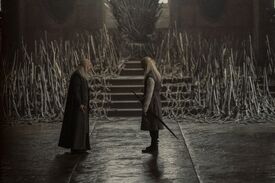
A deleted scene in which Viserys almost tells Daemon the prophecy.
- The scene of Baelon's birth was shortened: as Viserys holds the Valyrian steel dagger, a maester approaches him to inform him that Baelon is dead.[48]
- A scene after Aemma's death, in which Viserys hesitantly meets with Daemon to officially name him heir and tell him Aegon's prophecy, before ultimately deciding not to.[49]
In the books[]
This episode is adapted from the chapter "Heirs of the Dragon — A Question of Succession" from Fire & Blood. The story of that chapter was first published as the novelette The Rogue Prince, or, A King's Brother on June 17, 2014.
Gallery[]
Videos[]
Images[]
Stills[]
Screenshots[]
Concept art[]
References[]
- ↑ HOUSE OF THE DRAGON (HBO). The Futon Critic. Retrieved February 23, 2023.
- ↑ 2.0 2.1 2.2 House of the Dragon: Season 1, Episode 1: "The Heirs of the Dragon" (2022).
- ↑ House of the Dragon. HBO. Retrieved February 22, 2023.
- ↑ 4.0 4.1 House of the Dragon: Season 1. HBO. Retrieved March 4, 2023.
- ↑ 5.0 5.1 5.2 The Heirs of the Dragon. HBO. Retrieved February 22, 2023.
- ↑ Ryan Condal (2021). "The Heirs of the Dragon." Retrieved June 26, 2023.
- ↑ Den Of Geek, August 17, 2022
- ↑ HBO Twitter
- ↑ 9.00 9.01 9.02 9.03 9.04 9.05 9.06 9.07 9.08 9.09 9.10 9.11 9.12 House of the Dragon: The House That Dragons Built: Season 1, Episode 1: "Episode 01" (2022).
- ↑ Metro UK, August 29, 2022
- ↑ Penguin Random House, A Conversation with George R. R. Martin
- ↑ THR, August 30, 2022
- ↑ THR, August 22, 2022
- ↑ Den Of Geek, August 17, 2022
- ↑ THR, June 20, 2022
- ↑ PopSugar, August 22, 2022
- ↑ LA Times, August 21, 2022
- ↑ LA Times, August 21, 2022
- ↑ PopSugar, August 22, 2022
- ↑ LA Times, August 21, 2022
- ↑ LA Times, August 21, 2022
- ↑ Vanity Fair, "House of the Dragon Birth Scene", August 21, 2022
- ↑ Metro UK, August 27, 2022
- ↑ PopSugar, August 22, 2022
- ↑ Den of Geek, Targaryen Lore, August 21, 2022
- ↑ Insider, August 21, 2022
- ↑ io9, August 22
- ↑ Insider, August 21, 2022
- ↑ Insider, August 21, 2022
- ↑ House of the Dragon Official Podcast 1, from 57 to 60 minutes.
- ↑ Vanity Fair, August 15, 2022
- ↑ Prologue of the companion book Game of Thrones: House of the Dragon: Inside the Creation of a Targaryen Dynasty (2023)
- ↑ https://i.redd.it/wtljbelk3sb91.jpg
- ↑ https://twitter.com/SensaCineMx/status/1553187961000402944
- ↑ https://i.redd.it/0b6num8iske91.jpg
- ↑ https://www.instagram.com/p/CgyqNtnq1Sk/?igshid=YmMyMTA2M2Y=
- ↑ https://www.youtube.com/watch?v=3thsTSyEHHk
- ↑ https://www.westeros.org/Graphics/Images/220802_SE_HOTD_Contest_LocalPremiere_SQ_V2.jpg
- ↑ https://i.redd.it/ofpc6fym74i91.jpg
- ↑ https://zeenews.india.com/entertainment/web-series/disney-plus-hotstar-hosts-grand-premiere-of-house-of-dragons-in-mumbai-2498311.html
- ↑ https://i.redd.it/uzsufrp2vhe91.jpg
- ↑ https://www.newidea.com.au/house-of-the-dragon-premiere
- ↑ https://i.redd.it/lph4pch52bi91.jpg
- ↑ https://tiff.net/events/tiff-primetime-advance-screening-of-house-of-the-dragon
- ↑ https://georgerrmartin.com/notablog/2022/08/03/house-of-the-dragon-jcc-premier/
- ↑ Variety, August 22, 2022
- ↑ THR, House of the Dragon UK Launch, August 23, 2022
- ↑ Paddy Considine, Happy Sad Confused, October 14, 2022
- ↑ Paddy Considine, The New York Times, October 10, 2022
Notes[]
- ↑ 1.0 1.1 The Great Council at Harrenhal was held in 101 AC according to "The Heirs of the Dragon."
- ↑ 2.0 2.1 House of the Dragon starts in the year 112 AC according to the reference book Game of Thrones: House of the Dragon: Inside the Creation of a Targaryen Dynasty.
External links[]
The Heirs of the Dragon on A Wiki of Ice and Fire
 The Heirs of the Dragon on HBO
The Heirs of the Dragon on HBOThe Heirs of the Dragon on IMDb
 The Heirs of the Dragon on Max
The Heirs of the Dragon on MaxThe Heirs of the Dragon on Wikipedia

